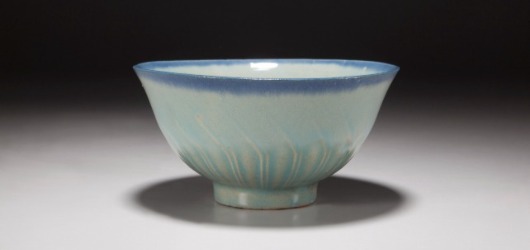Taiwanese Bowls with a Traditional Flavor Exhibition
September 8 st - 17th 2023 , 9:00-17:00, close every Monday.
Tracking down the earliest bowls in Taiwan requires a look into the archaeological history. In prehistoric times, a "bowl" was not necessarily made of clay. It could be a leaf, a piece of wood, bamboo, a stone tablet, or a shell that is used to hold food. The earthenware bowl though, does have a rich history stretching back thousands of years.


Around three, four hundred years ago, the Han Chinese began settling in Taiwan, bringing with them the glazed porcelain as well the snake kiln firing techniques to Taiwan. Firing went from low temperature firing of black stoneware bowls and red clay bowls using slip or lead glaze, to higher temperatures such as the blue and white porcelain bowls. While the rice bowls of the general public went from black to white, glazed blue and white thrown porcelain bowls had yet to become popularized. The concept of the "Taiwanese bowl" incorporated Chinese influences. Documents from the Japanese Occupation period left evidence of Ching Dynasty bowl kilns in Taiwan. The porcelain bowls from Yuchi in Nantou County and Beitou in Taipei City may have been the starting point of the craft of firing blue and white porcelain in snake kilns in Taiwan.
Bowl-making in Taiwan saw a revolution during the Japanese Occupation period. Kamoto Shozaburo produced "crane design bowls" in Nantou and the Tatun Pottery Workshop in Beitou and introduced the jigger for bowl production while switching to the noborigama and rectangular kiln for firing, significantly enhancing production rate. This forced the local businesses to improve upon their own production methods to keep up with the competition. With clay harvested in Beitou and the use of the washing technique, Taiwanese bowls became whiter and whiter and the transparent blue and white glaze became a trend, giving the bowl a bit of a Japanese element. The advent of decorative techniques such as painting, imprinting, and glaze spraying took Taiwanese bowls into a new era with a dizzying variety of colorful, distinctive styles.


After the war, the influx of large numbers of Chinese immigrants significantly increased demand for bowls in Taiwan, though only in quantity but not quality. As a result, inexpensive and mass-produced printed bowls saw overwhelming demand. Even traditional lead glazed yellow bowls of Yingge and the brown glaze of Shalu made a comeback, followed by the emergence of celadon glazed bowls. Social stability in the late 50's led to the injection of creativity in the design of the common bowls people use every day at home and food stalls alike. Taiwanese people had always favored the color red and a boisterous dinner table, so the plain elegance of celadon and simple prints could no longer satiate the public taste. Colorful paints were applied to printed bowls to add life, in particular, carmine red. The pinkish color is like the rouge that serves as the finishing touch on a woman's face, becoming a mainstay decoration on bowls and dishes alike. Regardless whether the subject of the design was animals or flowers, a little carmine red became a necessity. Carmine red bowls became a symbol of more prosperous life amongst the common folks of the 60's and 70's.
Then came the Tatung Porcelain, which made the almost translucent white porcelain bowl a staple of elegance in every household. Then came a glistening glaze with the yellow of an emperor's robe. Then came even more glamorous Taiwanese bowls of various colors. The prosperity of Taiwanese bowls, both colorful and pure white, reached a pinnacle during these times. In the 1990's, the ceramics industry bucked under the cost of labor and began leaving the country as the price of imported bowls undercut that of domestic ones. Bowls made in Taiwan saw a sharp decline and, to this day, only a few manufacturers remain on the island. Locally produced bowls are now hard to come by. The once ubiquitous porcelain bowls on the tables in homes, food stalls, and restaurants were gradually relegated to the footnotes of history books.


Renowned ceramist Lin Paochia once lamented that there was no "Taiwanese bowl" that belonged to the Taiwanese people. For the same reason, the master potter Tsai Jung-Yu had also aspired to consolidate the concept of a bowl that belongs exclusively to the Taiwanese people from the rice bowl that was the most common of vessels in our lives. Rice bowls were also often used to drink tea back in the days. The dragon pots used to serve tea could always be seen with a few old, black bowls sitting on the side. In the past, the same bowls were used for holding rice as for holding tea in Taiwan. Today, we have the Taiwan International Chawan Festival, which sees the separation of tea bowls from the common rice bowl of the Taiwanese every day life. The chawan now stands alone as a bowl created solely for the purpose of drinking tea.
Taiwanese Bowls with a Traditional Flavor" puts old bowls that were an inseparable part of our daily lives on display. From the extremely rare to the ubiquitous, these old bowls, created by master craftsmen decades ago, had brought richness and beauty to our culture. After traveling across time and space through the dimensions of aesthetics, they are now here for your viewing pleasures.
By tracing the past of these traditional bowls, we can take a look at the past of Taiwanese bowls through the lens of history and crafts and allow more people to set their eyes on the Taiwanese bowls that were a part of our common past.
By looking back at the past, we can look forward to the future of Taiwanese bowls.

